Making Dulce de Leche

Once you’ve tasted a proper homemade dulce de leche, you may never go back to regular caramel sauces again. It has just too much to bring to the flavor party. And as you’ll see, it’s not difficult at all to make. Start with your baking soda:
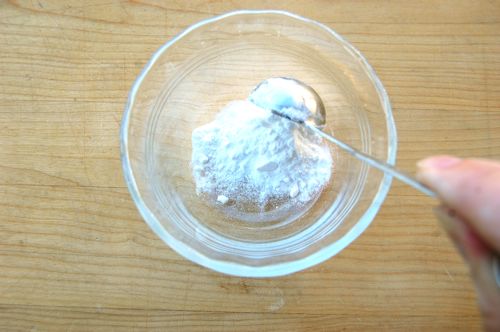
Add about half a cup of milk and stir it together.
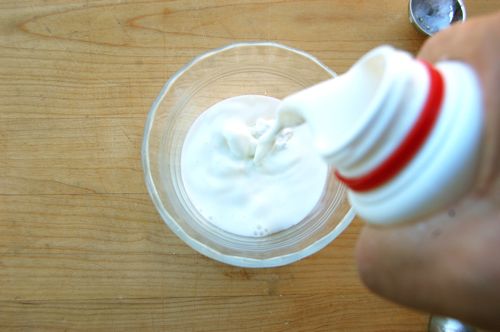
Now pour your cow’s milk into a broad saucepan or Dutch oven…
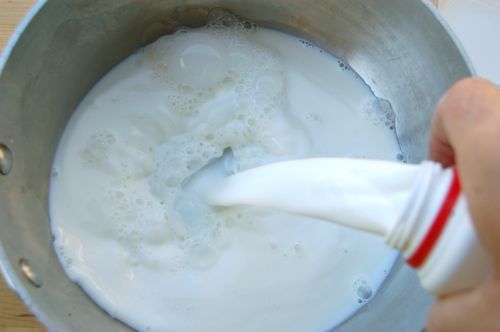
…followed by your goat’s milk.
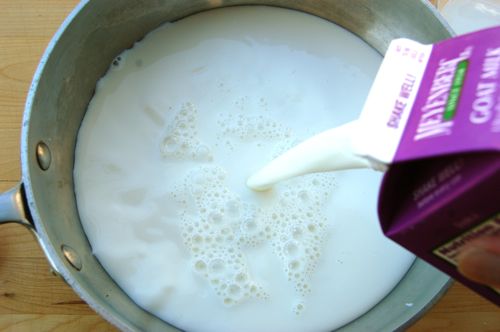
Pour in the sugar…
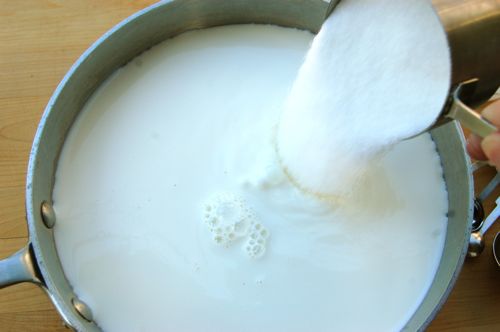
…then add any flavoring you might like. Here I’m adding some vanilla bean, a cinnamon stick — especially Mexican canela — would also be an excellent choice.
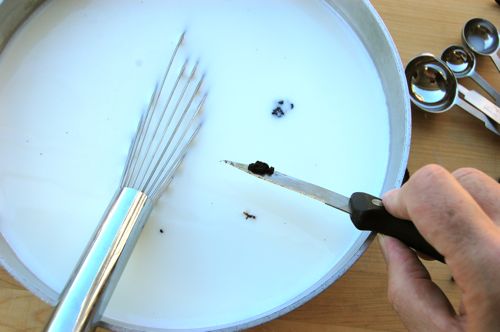
Whisk it all together and bring to a boil over medium-high heat.
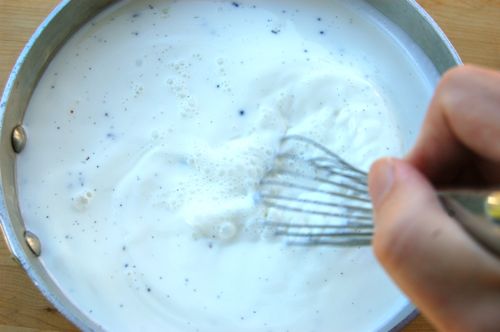
When the mixture is simmering, pour in the baking soda mixture. Now, could you mix this in at the beginning if you wanted to? Sure. However I’m not a big pot-watcher, and I’ve had my pan overflow on me as the mixture has heated and the reaction grown more intense. I simply like to know what to expect, and when. As I’ve said, I’m a uptight personality.

That she blows! Stir gently until the foam subsides. Turn the heat down to medium, or whatever level you need to keep the pan at a medium boil. Give it a stir every five minutes or so, making sure there’s nothing sticking to the bottom that might burn.
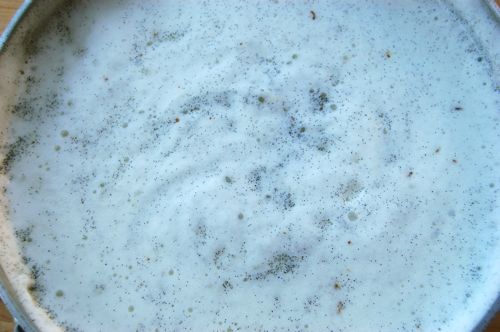
After 20 minutes to half an hour you’ll notice some browning. Keep boiling another half an hour or more, stirring a bit more frequently, until the dulce de leche is a deep brown and coats the back of a spoon.
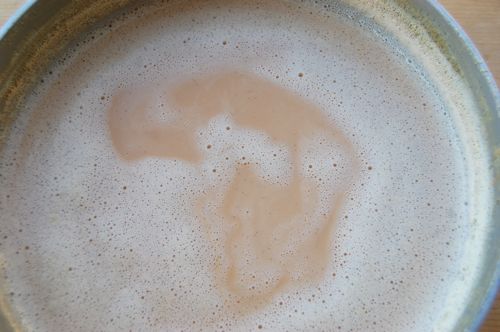
About like so:
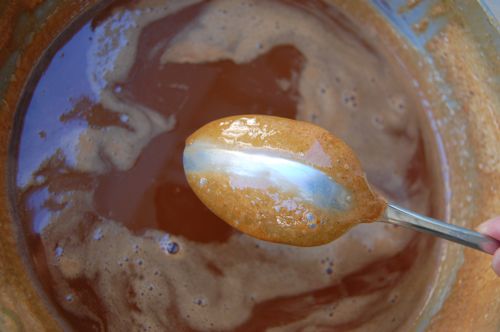
You should have 3 cups or even a little less. The consistency will be thinner than you might expect, but most certainly lip-smacking (it will also thicken as it cools). Just try the stuff. Can you reduce it further? Yes, though the mixture will get darker and darker as it cooks. By the time it’s down to a jam-like consistency it’s darker than I like. That’s why I suggest that if you want it thicker, just add more sugar at the outset. It will be a good deal sweeter, but it will stand up on a spoon. Me, I think a thinner dulce has more versatility in the kitchen. But however you like it, when you’ve reduced it enough, let it cool, then strain it into a container.
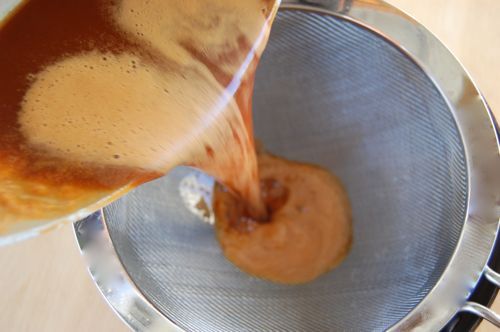
It will last just about forever, though mine disappears within days. My daughters would drink dulce de leche if I let them.
UPDATE: Reader Miguel adds that a cornstarch slurry can be added to a finished dulce de leche to thicken it. In Mexico, he says, cornstarch is often added to a dulce de leche before it is reduced to the degree I’ve done it, in order to create a pudding. Ingenious! I’ll have to try that one of these days. (I should add that you’ll want to add the cornstarch right at the point where you want to stop the cooking, wait for the thickening to occur, then take the mixture off the heat, since extended boiling of the starch will cause the dulce to thin back out again).
Joe, does dulce de leche need to be refrigerated? If you use it to fill a cake and then cover the cake with fondant, will it be OK for 24 hours? Thank you!
Hi Doris! Like most caramels, dulce de leche does not need to be refrigerated. However since I tend to keep mine for quite a long time, I do just to be on the safe side. It will certainly keep in a cake for 24 hours.
Is it safe to use unpasturised goat milk to make this? Made a batch just now with some raw goat milk before it crossed my mind. Will it be safe to eat?
Having tried both plain cow’s milk and now the half and half goat’s milk I can’t say I particularly love either one. The all cow wasn’t much of a wow for me. It tasted just like a fudge my mother used to make only softer. Tasted great but I think I was expecting fireworks.
And the 50/50 cow and goat concoction tastes ok but it’s one of those things that I can’t figure out if I like it or not. It has a kind of aftertaste. Is that normal?
If you mean it has an aftertaste of goat, it is normal. A little like goat cheese, yes? As for safety, while I’m not a big fan of using raw milks for safety reasons, you boil the milk with sugar for just about forever when you make cajeta. No bacteria could survive that. You’re good!
– Joe
Hi Joe, me again!
I’ve made this exact recipe quite a few times before and its always delicious. However I never get it quite as dark as you have it here, despite having accidentally reduced it to maybe 2.5 cups a time or two. Any idea why? Might The heat be too high/low? Maybe the baking soda Ive used isn’t as fresh (doubtful)?
Hey Kenny!
Could it be that you’re reducing it too fast? How long is it taking?
– Joe
Well over an hour, actually. Maybe 80 minutes… In a large heavy bottomed pan
Hey Kenny!
That’s about right. However I wonder if lower heat for a longer period might get you the color you want. That’s bit of a puzzler though. You might want to try a bit more soda in any case since it’s possible your milk is more acidic than normal and the soda is getting neutralized when you add it in.
Keep me informed!
– Joe